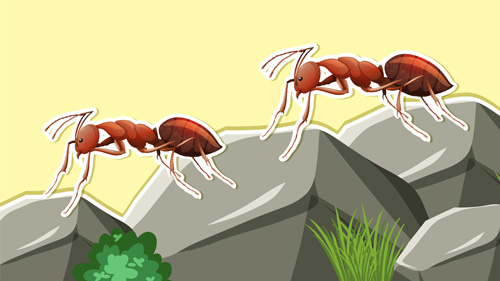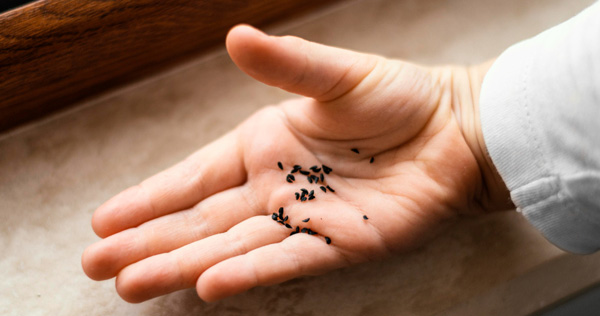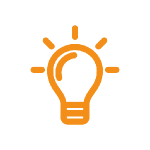Ever waged war against a tiny, six-legged army in your kitchen? Those scouts on the counter aren’t just looking for crumbs; they’re plotting an invasion. Ants – the uninvited guests that show up without fail every warm weather season, raiding our picnics and cozy kitchens. Ever wonder how to get rid of ants? Well, it’s time to turn your home into a no-ant zone.

The battle isn’t just about squashing invaders underfoot—it’s about outsmarting them at their own game. They march one by one but make no mistake: each ant is part of a bigger picture, connected through invisible scent trails back to a hidden fortress. We’ll arm you with natural remedies like essential oils and secret weapons such as diatomaceous earth so you can strike right at the heart—no harsh chemicals needed.
Come along—you’re about to become an expert in turning ant hills into molehills!
Identifying and Understanding Ant Infestations
Noticing a few more ants than normal around your space could mean it’s time to take stock of the situation. These tiny invaders are known for their remarkable ability to set up shop in nooks and crannies we often overlook. Spotting an ant trail or two can signal the beginnings of an infestation that could balloon if not addressed.
Introduction to Ants and Their Ecosystem Roles
Ants play vital roles in our ecosystem, but when they march into our homes uninvited, they become pests. They’re savvy survivors with worker ants tirelessly collecting food while leaving behind scent trails for others to follow—leading them straight into your pantry. Understanding these roles is crucial because sometimes what attracts ants indoors isn’t just crumbs; it’s also moisture from potted plants or pet bowls.
An introduction to ants would not be complete without mentioning their sheer variety. Different ant varieties bring different issues—from the wood-loving carpenter ant capable of structural damage, down to the common pavement ant spoiling your sugar jar delight.
Recognizing Common Ant Species in Your Home
Carpenter ants love moist wood like nobody’s business—they’re practically connoisseurs turning damp spots into art galleries of destruction right inside your walls. Pavement ants on the other hand are less about construction and more about scavenging through spilled food at every opportunity—even better if it’s something sweet like sticky jam left out during warm weather feasts.
Beyond species identification lies understanding how these critters think—or rather smell—their way around. Worker ants don’t miss a beat: one finds a good water source? Boom, there goes another one following its lead thanks to those ever-helpful scent trails laid down by its buddies.
Deciphering Ant Behavior and Colony Structure
The structure of an ant colony is fascinatingly efficient yet may spell trouble once they decide human habitats look cozy enough for nesting. A peek inside reveals highly organized societies where each member knows exactly what job they have—from caring for eggs all the way up to defending against threats (yes, even well-aimed squirts from natural repellants).
To truly get rid of unwanted six-legged guests though requires breaking apart this system by targeting entry points—those sneaky access points along window sills or near trash cans—that allow scouters easy passage back home after raiding kitchen counters clean off ripe fruit or whatever morsels lie uncovered on indoor trash cans lids loosely placed atop waste baskets brimming with goodies galore.
Discover strategic methods to shake up entire ant colonies with this in-depth guide, featuring effective techniques and practical tips. Dive into the details and learn how to tackle your ant problem like a pro.
Natural Ant Control Strategies
Got ants? You’re not alone. These industrious insects are famous for crashing picnics and colonizing kitchen counters. But before you declare war with chemicals, let’s talk nature’s arsenal against these tiny invaders.
Essential Oils as Natural Repellants
The same essential oils that soothe your senses can send ants packing. Peppermint oil is a champion at this—just a few drops where ants march, and they’ll turn tail. It disrupts their scent trails and confuses them to no end. Then there’s cinnamon leaf oil—it does more than spice up desserts; it sends ant scouts running for the hills. Dabbing some on entry points acts like an invisible barrier that says “keep out” in ant language.
If peppermint isn’t your jam, fear not: tea tree, lemon eucalyptus, or even clove oil can also discourage those six-legged party crashers without harsh chemicals that could ruin your day (or your sandwich).
Diatomaceous Earth for Eco-Friendly Pest Control
When diatomaceous earth enters the chat, ants exit stage left—and fast. This powdery substance is made from fossilized remains of aquatic organisms called diatoms—a natural wonder if there ever was one. Sprinkle this around suspected entry points, along window sills or near pet bowls where water draws them in like moths to a flame.
Sure enough, when an unsuspecting ant stumbles across this dusty obstacle course thinking it found buffet heaven—bam. The microscopic edges cut through its exoskeleton leading to dehydration city—for the ant only though; rest easy knowing Fido’s water bowl stays safe.
Battling these minuscule marauders doesn’t have to be Mission Impossible-style warfare loaded with toxins galore—an eco-friendly approach using common household items might just do the trick better than Tom Cruise dangling from ceilings ever could. Or you could take advantage of our ant control services in Utah.
Preventative Measures Against Ant Invasions
You know the drill. In a split second, your morning joe could be joined by an invasion of ants taking over your kitchen counter. But before declaring war with sprays and traps, let’s talk about making your place a fortress they just can’t crack.

Securing Food Sources from Ant Access
Banishing ants starts with taking away their VIP passes to the snack bar that is your home. Seal those window sills tighter than Fort Knox because even a crumb is like a flashing neon sign for scout ants. Next up: blocking access points where these tiny intruders sneak in.
Your mission? Think like an ant – what’s delicious and within reach? Start sealing food in airtight containers so tight not even Houdini could get into them. Remember that ripe fruit on the counter or sticky jam on shelves are practically throwing out welcome mats for our six-legged freeloading friends.
Now onto trash cans – don’t let indoor trash become an all-you-can-eat buffet. Make sure lids fit tightly; it’s simple but effective at keeping curious critters at bay.
If you’ve ever watched ants make trails back to their hideouts after feasting, then consider this: disrupt their scent trails by wiping down surfaces with vinegar or other cleaning agents — good riddance.
Last but certainly not least: pet bowls. Fido might be done chowing down but if there’s leftover kibble or water bowls left unattended, guess who’s coming to dinner?
Learn more about storing food properly so those little invaders have to pack up shop without as much as a nibble.
Remember folks, while chemical warfare may sometimes seem necessary when dealing with pests of the picnic-wrecking variety—prevention beats cure every time. So suit up (metaphorically speaking) and start safeguarding your homestead against unwanted six-legged guests today.
Comprehensive Guide to Using Ant Baits Effectively
When ants invade, reaching for the spray might seem like a quick fix. But did you know that using ant baits can actually be more like setting up an undercover operation inside those pesky colonies? Let’s talk strategy.
To target ant colonies successfully, think of ant baits as double agents. These crafty tools don’t just kill ants on contact; they trick worker ants into carrying poison back home. The goal here is total colony disruption from within—a covert mission with high success rates in controlling indoor infestations.
Nailing the Bait Placement
The key to baiting success lies in placement. Worker ants are always scouting for food sources and water source—so place your ant baits where these little invaders hit most often: near pet bowls, under window sills or potted plants, and along trails they frequent. It’s all about making it easy for them to find the bait but hard for pets and kids to access it.
Baits come in different forms: gels, granules, stations… you name it. Each type has its own way of attracting hungry ants looking for sustenance—the perfect setup if you ask me.
Becoming Irresistible: The Art of Choosing Effective Baits
Alluring scents make a world of difference when selecting your weapon—oops—I mean bait. Sugar-based options might snag some sweet-toothed pavement ants while protein-rich alternatives could tempt carpenter varieties instead.
Pssst… insider tip: Keep track of what gets carted off faster—it’ll tell you exactly what flavor hits their spot.
Sometimes though, patience really is a virtue because not every scout will fall for your trap right away—not until they’ve shared GPS coordinates with their buddies first. So give it time; after all good things (like an empty nest) come to those who wait…
Immediate Relief with Ant Sprays
Sometimes, when an army of ants invades your space, you need a quick victory. Reaching for ant sprays can be like calling in the cavalry — fast-acting and effective for immediate control over those pesky invaders. But before we go guns blazing, safety first. Always read labels to avoid any unwanted allergic reactions or hazards.

Understanding Ant Spray Mechanics
Ant sprays work by delivering a lethal dose of chemicals that not only kill on contact but also linger to deter new arrivals. It’s all about disrupting their scent trails and putting up a “no vacancy” sign at your entry points. Just imagine: one minute they’re marching towards that sticky jam left on the counter, and the next thing they know – it’s game over.
The key here is precision; aim directly at ant trails or nests rather than going full-on wild west with your spray bottle. Overuse won’t do more than just waste product; it could even attract more ants seeking a good water source if they mistake the liquid as something beneficial.
Selecting The Right Spray For Your Home
Choosing an ant spray isn’t just picking any old can off the shelf — think of it as matchmaking for pest control. You’ve got options from natural plant-based formulas featuring essential oils known to pepper ants’ senses (in all the wrong ways) to stronger chemical concoctions designed for heavy hitters like carpenter ants.
No matter which sidearm you choose in this duel against unwelcome six-legged outlaws, make sure kids and pets are clear from spraying zones because even though these products offer relief faster than you can say ‘ant infestation,’ some ingredients might not play nice with sensitive individuals.
Find out how effective ant baits are compared to sprays here. With strategic placement around food sources like pet bowls or trash cans indoors—where these critters love setting up camp—you’ll soon have them heading for greener pastures…or shall we say less chemically-enhanced ones?
Combating Outdoor Ant Activity
Those tiny invaders marching around your outdoor garbage bins and compost heaps aren’t just annoying; they’re a full-blown signal of outdoor ant activity. But don’t fret, we’ve got the scoop on how to show them who’s boss in their own backyard battlefield.
Natural Strategies: Diatomaceous Earth & Essential Oils
Battle these pests with diatomaceous earth, an all-natural powder that works like microscopic razor blades to cut through ants’ exoskeletons—talk about an unwelcome mat. Just sprinkle it around common entry points for a non-toxic barrier. For those seeking scents over violence, essential oils such as cinnamon leaf or peppermint are Mother Nature’s way of saying “keep out” without harming the environment.
Mix up your battle plan by attacking their communication lines. A dash of cayenne pepper disrupts scent trails and sends worker ants into disarray—no more following the leader.
Tactical Baiting Operations
If you’re dealing with more than just scouts and have a full-on invasion, strategic bait placement can turn the tide. Think of ant baits as double agents working from inside enemy territory—they carry toxic treats back to base camp, eliminating colonies at the source. It’s true what they say: keep your friends close but your enemies closer… especially if you’re feeding them poison.
The Spray Assault for Immediate Control
Sometimes you need results yesterday when facing an onslaught of six-legged foes near picnic areas or patios. In this case, ant sprays come in handy for quick knockdown power while planning long-term strategies—but always remember safety first. No one wants Aunt Martha slipping on ant carcasses during her visit.
No matter which method you choose to protect your fortress from these miniature marauders, remember that consistent action is key—and sometimes combining forces gives you that extra edge in warfare against unwanted insect invasions outdoors.
Dealing With Carpenter Ants
If you’ve noticed a fine sawdust near your window sills or heard faint rustling inside the walls, it’s time to suspect carpenter ants. Unlike their pavement-loving cousins, these wood-burrowing insects can compromise your home’s structural integrity.
Behavior of Carpenter Ants
Carpenter ants don’t actually eat wood; they excavate it to build nests. Spotting large black ants with straight antennae is often the first sign of an infestation. They prefer moist environments—so check around sinks and tubs for these unwelcome house guests.
To tackle them head-on, understanding their behavior is crucial. They are most active during warm weather when searching for food sources like spilled food or sticky jam that wasn’t cleaned up properly.
Eliminating Carpenter Ants
The key to eliminating carpenter ants lies in targeting not just the workers but also their nest. Start by tracing back ant trails—this might lead you directly to the main colony hiding behind those pristine walls of yours.
A good water source attracts them too, so fix any leaks pronto. Then get down and dirty with some ant baits. Place them strategically where ant activity is high; this way, worker ants carry poison back to their nestmates unknowingly committing mass insecticide.
Maintaining cleanliness goes a long way in preventing future invasions—keep indoor trash cans closed and clean pet bowls regularly because trust me, nothing says “Welcome” quite like ripe fruit lying next to open lids tightly filled with last night’s dinner leftovers.
You want relief without turning your place into a biohazard zone? Go natural: try placing cinnamon leaf oil-soaked cotton balls at entry points—the smell messes with their scent trail communication big time. Or if you’re feeling extra crafty today sprinkle fossilized remains of aquatic organisms called diatoms (yes, diatomaceous earth) along windowsills—it works wonders on exoskeleton-clad trespassers looking for warmth indoors.
But hey—if all else fails and that wall sounds more like a woodworking shop than part of your peaceful abode then consider calling in professionals who specialize in severe ant infestations. Sometimes letting pros handle business means saying goodbye faster—and less painfully—to our six-legged squatters.
Non-Toxic Methods for a Safe Environment
Prioritize health by utilizing non-toxic methods that are safe for both humans and pets while effectively managing an ant problem. Ant invasions can be a real buzzkill, but who says you need to wage chemical warfare in your own home? Going the non-toxic route is like choosing salad over fast food—it’s all about keeping things healthy. Now, vinegar might not be your go-to condiment, but it sure packs a punch against ants with its repelling power.
Natural Remedies: The Secret Weapons in Your Pantry
You’ve got an arsenal of natural remedies just waiting to show those pesky ants the door. Citrus peels are more than just snack leftovers; they’re ant kryptonite when scattered around potential entry points or blended into a homemade spray that makes ants turn tail. And let’s talk essential oils—these aren’t just for making your house smell like a spa day gone wild. A few drops of cinnamon leaf oil near windowsills and doorways tell ants this isn’t their party.
Diatomaceous earth is another gem from Mother Nature’s pest control playbook—a fine powder made from aquatic organisms called diatoms that dries out invaders without any toxic side effects on pets or little ones crawling around. Just sprinkle this fossilized remains along known ant trails and watch it work its magic.
Making Your Home Fort Knox Against Ants
Sure, you could try sealing every nook and cranny to keep ants at bay—or you could simply make your place less inviting by storing ripe fruit away from counters and keeping indoor trash cans with lids tightly sealed (because nothing screams “buffet” quite like sticky jam smeared on cardboard). It’s also smart to wash dishes immediately; after all, if there’s no food source left behind there’ll be fewer reasons for uninvited guests.
To really drive them nuts—and out—place some peppery spices where these critters roam most frequently. Cayenne pepper or black pepper might jazz up our meals but leave those scent trails leading nowhere fast as far as our six-legged foes are concerned.
Professional Extermination Services Review
Sometimes, the ant battle in your home feels like a full-blown war. You’ve tried everything from homemade concoctions to store-bought traps, but those little invaders just won’t wave the white flag. When DIY solutions fail, it’s time to enlist the help of professional exterminators.
When DIY solutions are as effective as using a flyswatter against an elephant, professional exterminator services step up to bat with their expertise on severe ant infestations. They come armed with tools and tactics that make ants’ knees—if they had them—quiver in fear.
An expert can identify whether you’re dealing with pavement ants who love picnicking on your pantry goods or carpenter ants that treat your home’s woodwork like a chew toy. With this knowledge, they strategize and deploy baits that do more than kill one or two foragers; these baits invite themselves back into colonies for dinner parties of doom.
The Strategic Use of Baits by Professionals
To get rid of pesky indoor explorers effectively, pros often turn to ant baits. Unlike sprays that merely banish visible intruders temporarily, baits work insidiously behind enemy lines. Ants carry lethal treats back home unwittingly providing their entire colony—including the queen—a last supper.
Remember though—while it might be tempting to watch and celebrate each tiny victory as ants fall prey to these clever traps—it’s essential not only for effectiveness but also safety reasons not directly interfere with bait stations once placed by professionals.
Spraying Your Way To Immediate Relief
Ant sprays, used correctly under guidance from seasoned exterminators offer instant gratification for homeowners tormented by trails of trespassers across countertops overnight—but remember. Safety first always comes before sweet revenge against insect invaders; read labels carefully and keep kids/pets at bay during application times recommended by experts.
The Great Outdoors: Not Just A Picnic Spot For Ants Anymore
Battling outdoor ant activity takes different ammo since environmental conditions play ball too—you don’t want toxins seeping into soil where pets could dig around later nor near edible plants risking contamination. Experts apply specialized treatments keeping Mother Nature happy while showing uninvited guests out—and believe me if stats were any indication then surely success rates speak volumes here too—with reports suggesting significant control over extensive outdoor activity post-treatment applications.
Conclusion
You’ve learned the art of ant eviction, and now your home can be a fortress again. Essential oils are your allies, with scents that send ants marching away for good. Diatomaceous earth stands as a natural guardian at entry points—no trespassers allowed. From cinnamon leaf to peppermint, these fragrant warriors leave no room for pests. Your pantry is now an impenetrable vault; food sealed tight keeps scouts at bay.
To get rid of ants fast means understanding their world—a hidden network beneath our feet—and breaking it apart from within using baits and sprays when necessary. Your garden’s no longer an ant haven but a tranquil retreat thanks to outdoor treatments designed just right.
This journey has equipped you with more than tactics—it’s given you peace of mind in knowing that safe, effective control is truly possible.

Did you know?
Beeline uses products that are approved by the EPA and rated for use in Hospitals, Day Care Centers, Restaurants and Veterinary Clinics.
Get a Quick Quote
Complete the form below and an agent from our team will contact you right away.




